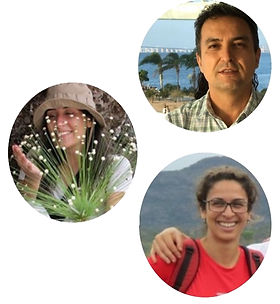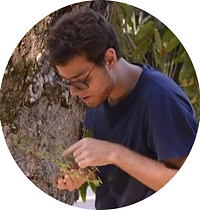Programação
Lembre que a nossa missão é tornar o processo de leitura de artigos científicos uma atividade agradável, compartilhada em grupo, de forma a superar as dificuldades individuais e avançar em temas diversos, valorizando o fazer ciência.
Nossos encontros ocorrem nas quintas-feiras às 16h (GMT-3) pelo Google Meet, segundo a programação detalhada abaixo. Para receber o link do encontro não hesite em nos contatar preenchendo o formulário.
Se quiser, você também pode sugerir novas atividades através deste formulário.
2020
10/12 - Palestra!
Dra. Carolina M. Siniscalchi
Título: Angiospermas no limite: extremos, diversidade e filogenia.
26/11 - Palestra!
MSc. Maria Beatriz de Souza Cortez
Título: A relação entre a idade das comunidades vegetais e as características ambientais em OCBILs.
12/11 - Discussão
Texto: Lughadha et al. 2020. "Extinction risk and threats to plants and fungi".
29/10 - Palestra!
Prof. Dr. Paulo M. Gonella
Título: Conservação de plantas carnívoras na era da extinção.
24/09 - Palestra!
Dra. Caroline O. Andrino
Participação de Prof. Dr. Paulo Sano e Profa. Dra. Fabiane Costa
Título: Filogenia de Paepalanthus (Eriocaulaceae), uma diversa linhagem de monocotiledôneas neotropicais.
09/09 - Discussão
Texto: Peters M. et al. 2019. "Climate-land-use interactions shape tropical mountain biodiversity and ecosystem functions"
02/09 - Palestra!
MSc. Matheus Colli Silva
Título: "Evaluating shortfalls and spatial accuracy of biodiversity documentation in
the Atlantic Forest, the most diverse and threatened Brazilian phytogeographic domain"
26/08 - Discussão
Texto 1: Meierotto S. et al. 2019. A revolutionary protocol to describe understudied hyperdiverse taxa and overcome the taxonomic impediment.
Texto 2: Zamani A. et al. 2020. The omission of critical data in the pursuit of 'revolutionary' methods to accelerate the description of species.
18/08 - Discussão
Texto: Devecchi M. et al. 2020. Beyond forests in the Amazon: biogeography and floristic relationships of the Amazonian savannas.
04/08 - Palestra!
BSc. Luísa Lucresia de Sales Ribeiro
Titulo: Distribuição de Myrtaceae nas diferentes fitofisionomias da Cadeia do Espinhaço: Composição Florística e Influência Ambiental.
Texto adicional: Campos L. et al. 2019. Biogeographical Review of Asteraceae in the Espinhaço Mountain Range, Brazil.
21/07 - Discussão
Texto 1: Reginato M. et at. 2020. Is dispersal mode a driver of diversification and geographical distribution in the tropical plant family Melastomataceae?
Texto 2: Lagomarsino L. et al. 2016. The abiotic and biotic drivers of rapid diversification in Andean bellflowers (Campanulaceae).
14/07 - Palestra!
IC. Mirian de Camargo Andrade Antonicelli
Titulo: Adaptações morfológicas de plantas ao ambiente montano da Cadeia
do Espinhaço: Tibouchina (Melastomataceae).
Texto adicional 1: Simon M. et al. 2009. Recent assembly of the Cerrado, a neotropical plant diversity hotspot, by in situ evolution of adaptations to fire.
Texto adicional 2: Moles A. et at. 2020. A hairy situation: Plant species in warm, sunny places are more likely to have pubescent leaves.
07/07 - Discussão
Texto: Meseguer A. & Condamine F. 2020. Ancient tropical extinctions at high latitudes contributed to the latitudinal diversity gradient.
30/06 - Discussão
Texto: Zizka A. et al. 2020. Transitions between biomes are common and directional in Bombacoideae (Malvaceae).
23/06 - Discussão
Texto: Vasconcelos T. et al. 2020. Fast diversification through a mosaic of evolutionary histories characterizes the endemic flora of ancient Neotropical mountains.
16/06 - Discussão
Texto: Luebert F. et al. 2020. Clade-specific biogeographic history and climatic niche shifts of the Southern Andean-Southern Brazilian disjunction in plants. In: Rull V. & Carnaval A. (eds). Neotropical diversification: patterns and processes.
Texto adicional 1: Simon R. et al. 2011. Biogeographic implications of the striking discovery of a 4,000 kilometer disjunct population of the wild potato Solanum morelliforme in South America.
Texto adicional 2: Schenk J. & Saunders K. 2017. Inferring long‐distance dispersal modes in American amphitropically disjunct species through adaptive dispersal structures.
09/06 - Discussão
Texto: Peres E. et al. 2020. Patterns of species and lineage diversity in the Atlantic rainforest of Brazil. In: Rull V. & Carnaval A. (eds). Neotropical diversification: patterns and processes.
Texto adicional 1: Ledo R. & Colli G. 2017. The historical connections between the Amazon and the Atlantic Forest revisited.
Texto adicional 2: Leite Y. et al. 2016. Neotropical forest expansion during the last glacial period challenges refuge hypothesis.
02/06 - Discussão
Texto: Baker P. et al. 2020. Beyond Refugia: New insights on Quaternary climate variation and the evolution of biotic diversity in tropical South America. In: Rull V. & Carnaval A. (eds). Neotropical diversification: patterns and processes.
Texto adicional 1: Antonelli A. et al. 2018. Amazonia is the primary source of neotropical biodiversity.
26/05 - Discussão
Texto: Cracraft J. et al. 2020. The origin and evolution of amazonian species diversity. In: Rull V. & Carnaval A. (eds). Neotropical diversification: patterns and processes.
Texto adicional 1: Hoorn C. et al. 2010. Amazonia through time: andean uplift, climate change, landscape evolution, and biodiversity.
Texto adicional 2: Baker P. et al. 2014. The emerging field of geogenomics: constraining geological problems with genetic data.
12/05 - Discussão
Texto: Silveira F. et al. 2020. Diversification in ancient and nutrient-poor neotropical ecosystems: how geological and climatic buffering shaped plant diversity in some of the world’s neglected hotspots. In: Rull V. & Carnaval A. (eds). Neotropical diversification: patterns and processes.
Texto adicional 1: Hopper S. 2009. OCBIL theory: towards an integrated understanding of the evolution, ecology and conservation of biodiversity on old, climatically buffered, infertile landscapes.
Texto adicional 2: Mucina L. & Wardell-Johnson G. 2011. Landscape age and soil fertility, climatic stability, and fire regime predictability: beyond the OCBIL framework.
Texto adicional 3: Silveira F. et al. 2016. Ecology and evolution of plant diversity in the endangered campo rupestre: a neglected conservation priority.
04/05 - Discussão
Texto: Guedes T. et al. 2020. Diversity, endemism, and evolutionary history of montane biotas outside the andean region. In: Rull V. & Carnaval A. (eds). Neotropical diversification: patterns and processes.
27/04 - Discussão
Texto: Azevedo J. et al. 2020. On the young savannas in the Land of ancient forests. In: Rull V. & Carnaval A. (eds). Neotropical diversification: patterns and processes.
Texto adicional 1: Collevatti R. et al. The diversification of extant angiosperms in the South America dry diagonal. 2020. In: Rull V. & Carnaval A. (eds). Neotropical diversification: patterns and processes.






